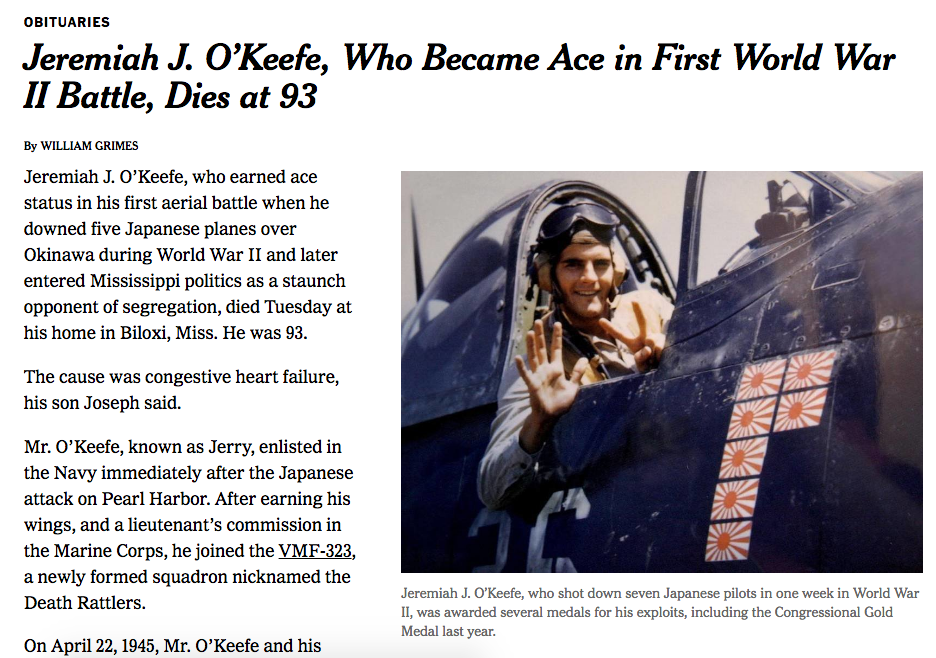I was reading through the paper this morning when this headline caught my eye: “Jeremiah O’Keefe, Ace in His First World War II Battle, Dies at 93”.
I didn’t recognize the face of the man in the fighter plane, but down the page, there was a second photo of a man — the same face, but older, well into his 80s. I recognized that one.
I’d met him before.
I met Jeremiah O’Keefe — Jerry, to everyone around town — during my summer in Biloxi, Miss., in 2010. I interviewed him once at his home that July, just as I was getting started on Stry.us. I didn’t have a working website yet. I hadn’t published a single story. But he was gracious and gave me an hour of his day. We talked about his time in the Navy and his work running the town’s funeral home; about how he came to politics; about the time he tried to stop the Klan; about the projects he built in Biloxi, and the ones he didn’t. I wrote a story about his time as mayor, and gave it the headline, “The Man Who Tried to Save Biloxi.” Below that headline, I wrote:
“Four years after Hurricane Camille, in a town the storm left for dead, the man running the local funeral home decided to give his city new life.”
I wrote a lot of stories that summer about death and rebirth in Biloxi, but none quite as literal as Jerry’s.
And it’s really something that today, of all days, is the day Jerry’s obituary appeared in the New York Times. You might not realize this, but today is the 11th anniversary of the day Hurricane Katrina made landfall on the Gulf Coast, and changed that part of the South forever. It would be easy not to know about the anniversary — after all, if you’re living pretty much anywhere outside the Gulf, you won’t be reading about the storm today. Those of us in the media simply don’t cover the 11th anniversaries of disasters — even those as life-changing as Katrina.
Here’s what I wrote about Katrina a year ago today over on Stry.us:
There is a particular disaster narrative that springs up after an enormous storm, and Katrina was no exception to the rule. The storyline is simple:
In the days after the storm, the story is one of loss.
A year after the storm, the story is one of recovery.
Five years after the storm, the story is one of remembrance.
10 years after the storm, the story is one of rebirth.
That’s the disaster narrative, and Katrina’s story has followed it to the letter: Loss. Recovery. Remembrance. Rebirth. Joplin is four years in to the disaster narrative; the Jersey Shore is two. But the stories of tornado recovery in Joplin will be everywhere next summer; in two years, we’ll read recovery stories from Sandy. On the 10-year anniversary, we’ll read of rebirth, same as it always was.
But this is the last Katrina anniversary you will ever read about.
After 10 years, an interesting thing happens: The disaster ceases to be a part of the present, and becomes something of the past. After 10 years, reporters stop writing about how the storm is affecting people’s lives today. Remember: This is a story that began with loss, and ends with rebirth. The story doesn’t go on forever; there is no epilogue.
So for Katrina’s story, this ends here. You will not read a front page story in the New York Times about the 11th anniversary of Katrina. You will not see a site like BuzzFeed put together a package on the 15th anniversary of the storm. And by the time the 20th anniversary rolls around, or the 25th, Katrina will simply be something of the past.
Of course, I opened the paper today, and there was no front page story about Katrina.[1. Of the major national publications, only the Huffington Post ran a story about Katrina today. Credit to them for keeping the story alive.] But on page B6 of the New York Times, there is a story about Jerry O’Keefe. And his story is the coast’s story, too.
So on this day, 11 years after Katrina hit the coast, I wanted to say:
Jerry, I’m grateful for the time you gave me back in 2010, and the conversation we had. You didn’t need to give a young reporter a chance, but you did. Thank you for sharing your story with me.
And Jerry, I wanted you to know: Whenever I think of you, I think about this stretch of beach out in front of your Mississippi home. Dating back to the 1950s, you told me that you’d planted palm trees out front. When a big hurricane came through and knocked the trees down — like with Hurricane Camille, and later Katrina — you’d go back and replant new ones in the sand. It was one of my favorite symbols of Katrina, those trees down by Highway 90. What the storms would take away, you’d find away to bring back. In Biloxi, there was death and rebirth — always.
I know, Jerry, that you’re gone, but there will be another storm. On the Gulf Coast, there’s always another.
And when that storm comes, and when it knocks down your palm trees, I wonder: Will someone come now to replace them?
I hope they will, Jerry.


